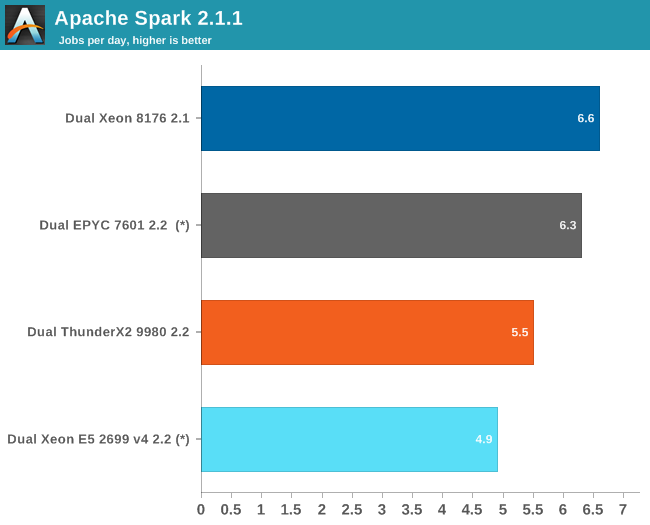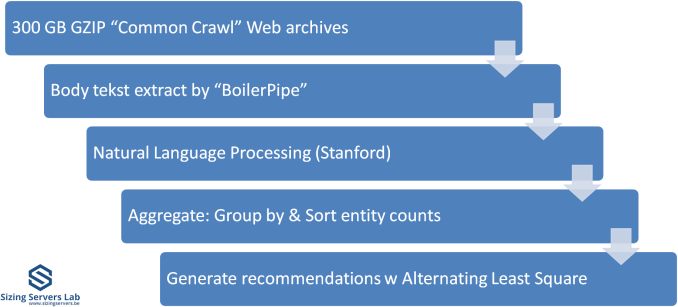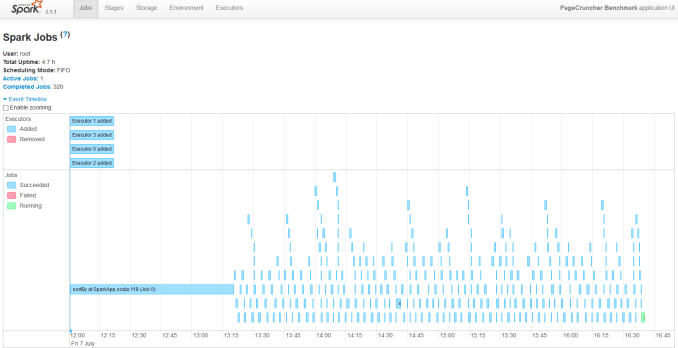Assessing Cavium's ThunderX2: The Arm Server Dream Realized At Last
by Johan De Gelas on May 23, 2018 9:00 AM EST- Posted in
- CPUs
- Arm
- Enterprise
- SoCs
- Enterprise CPUs
- ARMv8
- Cavium
- ThunderX
- ThunderX2
Apache Spark 2.x Benchmarking
Last, but not least, we have Apache Spark. Apache Spark is the poster child of Big Data processing. Speeding up Big Data applications is the top priority project at the university lab I work for (Sizing Servers Lab of the University College of West-Flanders), so we produced a benchmark that uses many of the Spark features and is based upon real world usage.
The test is described in the graph above. We first start with 300 GB of compressed data gathered from the CommonCrawl. These compressed files are a large amount of web archives. We decompress the data on the fly to avoid a long wait that is mostly storage related. We then extract the meaningful text data out of the archives by using the Java library "BoilerPipe". Using the Stanford CoreNLP Natural Language Processing Toolkit, we extract entities ("words that mean something") out of the text, and then count which URLs have the highest occurrence of these entities. The Alternating Least Square algorithm is then used to recommend which URLs are the most interesting for a certain subject.
To get better scaling, we run with 4 executors. Researcher Esli Heyvaert reconfigured the Spark benchmark so it could run on Apache Spark 2.1.1.
Here are the results:

(*) EPYC and Xeon E5 V4 are older results, run on Kernel 4.8 and a slightly older Java 1.8.0_131 instead of 1.8.0_161. Though we expect that the results would be very similar on kernel 4.13 and Java 1.8.0_161, as we did not see much difference on the Skylake Xeon between those two setups.
Data processing is very parallel and extremely CPU intensive, but the shuffle phases require a lot of memory interactions. The time spent on storage I/O is negligible. The ALS phase does not scale well over many threads, but is less than 4% of the total testing time.
The ThunderX2 delivers 87% of the performance of the twice as expensive EPYC 7601. Since this benchmark scales well with the number of cores, we can estimate that the Xeon 6148 will score around 4.8. So while the ThunderX2 can not really threaten the Xeon Platinum 8176, it gives the Gold 6148 and its ilk a run for their money.












97 Comments
View All Comments
imaheadcase - Sunday, May 27, 2018 - link
Yah i tried that for a bit, it worked ok. But was not foolproof, it missed some stuff.repoman27 - Wednesday, May 23, 2018 - link
Just to provide a counter point, this article made my day. And that’s coming entirely from intellectual curiosity—I don’t plan on deploying any servers with these chips in the near future. I always enjoy Johan’s writing, and was really looking forward to seeing how ThunderX2 would stack up. Many people are convinced that ARM is really only suitable in low power / mobile scenarios, but this is the chip that may finally prove otherwise. That has significant ramifications for the entire industry (including the consumer space), especially when you consider that Cavium could put out a TSMC 10nm or even 7nm shrink of ThunderX2 before Intel can get off of 14nm.HStewart - Wednesday, May 23, 2018 - link
This does not proved that ARM is suitable in higher end space - look at the core specific speed - it extremely low compare to Intel and AMD server chips. Keep in mind it takes 128 total cores - running at 4SMT system. And what about other operations - what about Virtual Machine situation - where you have many virtual x86 machines on VMWare server,How about high end mathematical and vector logic?
It does seem like ARM can run more threads - but maybe Intel or AMD has never had the need to
I think this latest Core battle is silly - I think it really not the number of cores you have but combination of type and speed of cores along with number of cores.
Wilco1 - Wednesday, May 23, 2018 - link
It certainly does prove that Arm can do high end servers - the results clearly show IPC/GHz is very close on SPECINT. Base clock speeds are the same as the Intel cores, and that's the speed the server runs at when not idle. But there are more cores as you say, so who will win is obvious.Now imagine a next-gen 7nm version before Intel manages 10nm. Not a pretty picture, right?
HStewart - Wednesday, May 23, 2018 - link
Ok I have learn to agree to disagree with some peopleCan this server run the VMWare server
https://kb.vmware.com/s/article/1003882
The answer is no - just one example - many more,
On 10nm - it not number that matters - it technology behind it - Intel supposely has a i3 and Y based for CannonLake coming this year - probably more.
Wilco1 - Wednesday, May 23, 2018 - link
There are plenty of VMs for Arm, so virtualization is not an issue.10nm will be behind 7nm even if it ends up as originally promised and not using relaxed rules to become viable for volume production.
ZolaIII - Thursday, May 24, 2018 - link
When optimized for SIMD NEON extension things changed dramatically. All tho NEON isn't exactly the best SIMD never the less number's speak for them self.https://blog.cloudflare.com/neon-is-the-new-black/
Tho Centriq is a bit pricier, bit overly slower than this but main point is it whose built on comparable lithography to current Intel's 14nm. So you get cheaper hardware, which can be packaged tighter & will consume much less power while being compatible regarding the performance. Triple win situation (initial cost, cost of ownership and scaling) but it still isn't turn key one whit isn't crucial for big vendor server farms anyway.
name99 - Thursday, May 24, 2018 - link
ARM (and this particular chip) aren't trying to solve every problem in the world. They're trying to offer a better (cheaper) solution for a PARTICULAR subset of customers.If you think such customers don't exist, then why do you think Intel has such a wide range of Xeons, including eg all those Xeon Silvers that only turbo up to 3GHz? Or Xeon Gold's that max out at 2.8GHz?
lmcd - Thursday, May 24, 2018 - link
Second page: supports SR-IOV, which is important for KVM and Xen. If you're not aware, Xen and KVM are powerful virtualization solutions that cover the feature set of VMWare quite nicely.HStewart - Wednesday, May 23, 2018 - link
"I really think Anandtech needs to branch into different websites. Its very strange and unappealing to certain users to have business/consumer/random reviews/phone info all bunched together."I different in this - I don't think AnandTech should concentrate on just gaming in focus - this is rather old school - I am not sure about mobile phones in the mess of all this
But comparing ARM cpu's to Intel/AMD is interesting subject. It basically RISC vs CISC discussion - yes RISC can do operations quicker in some cases - but by definition of the architecture they are Reduce in what they do. Fox example it would take RISC a ton of instructions to executed a single AVX style operation.
This article is closest I have seen in comparing ARM vs x86 base machines - but even though I see some holes - it comes close - but having just be Linux based leaves out why people purchase such machine - I think Virtual Machine server is huge - but like everything else on the internet that is just an opinion